Sink Plunger vs Toilet Plunger: Differences & Similarities
Standard sink and flange toilet plungers are the most common household tools you look for when you have blockages in drains and pipes be it in the toilet, kitchen or bathroom. While they’re built to help you clear clogs easily without having to call a plumber, sink and drain plungers are different in terms of design and usage.
A sink plunger has a rubber cup with a reinforced flat circular end ideal for fixtures with leveled surfaces such as sinks, bathtubs or floor drains while a toilet plunger has a cup with an additional soft rubber flap that folds out from inside the cup to fit into non-level fixtures such as toilet drains and holes.
It’s not unlikely that you have used a sink plunger to unclog your toilet. Well, it might have worked/not worked, but remember using the right plunger gets the job done correctly while avoiding damages to your household fittings.
Read on to discover the differences between the sink and toilet plungers, in terms of how they look, their features, where to use them appropriately, the similarities and some of the brands.
Differences
Following is a table highlighting the main differences between a sink and a toilet plunger.
| Sink Plunger | Toilet Plunger |
| Also known as the cup, or standard plunger | Also known as drain or flange plunger |
| Open cup-shaped without a flange/flap | Has a bell-shaped cup with a rubber flap(flange) from inside |
| Ideal for flat surfaces such as kitchen and bathroom sinks, bathtubs and shower drains | Best for non-flat surfaces such as toilet drains. Can also be used for flat surfaces. |
| The suction cup has a larger surface area | The suction cup has a smaller surface area |
| Come with slightly smaller black or red rubber cups | Come with larger rubber cups that are mostly black in color |
| The standard sink plunger comes in just mostly comes with a shorter handle that is made of wood. | The drain plunger has a slightly taller handle made of plastic, metal and sometimes wood. |
| Smaller air volume results in less suction power | Larger air volume and tight seal enhance the suction power |
| Possible splashes when plunging non-flat surfaces; often turns inside out breaking the seal | No splashes, they perfectly seal the end of the drainpipe |
| Easier to use and clean | Can be a little challenging to use and clean |
| Basic design | Design with more features |
| Inexpensive | Slightly expensive |
Sink Plunger
The sink/cup plunger is also referred to as the standard plunger since it’s the most common in many households. In fact, it is sometimes incorrectly used. A lot of individuals can attest to having the universal cup-shaped suction that they use for their kitchen, bathroom, and sometimes the toilet.
It features a rubber cup with a flat bottom attached to a straight wooden handle. The handle sizes may differ, but the structure is unilateral.
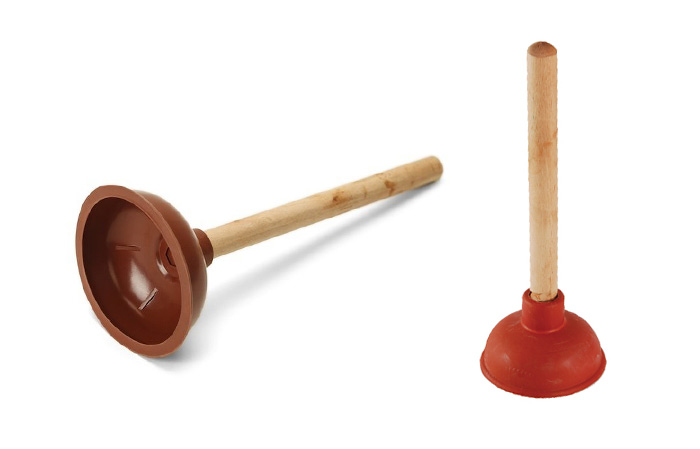
A sink plunger works best on flat surfaces such as sinks, bathtubs, and floor drains. The flat-bottomed rubber cup seals over the drain opening creating a vacuum. When you thrust the handle, the pressure of the water moving up and down dislodges the clog.
This particular plunger can also be used in the toilet, however, the drainage area of the bowl doesn’t have a flat base, which means it will not create a tight seal.
This improper positioning is what makes it difficult to use to dislodge any clogs since there isn’t enough suction and there’s likely to be plenty of water splashing.
Additionally, standard plungers don’t offer adequate push and pull force compared to the toilet variant. This is because of the air volume differences. Sink plungers have a smaller hair volume compared to the toilet plungers
Toilet Plunger
A toilet plunger has a longer handle and a soft, smaller cup (known as a flange) that extends down the bottom end of the larger cup plunger. Due to the flange, this type of toilet plunger also goes by the name flange plunger.
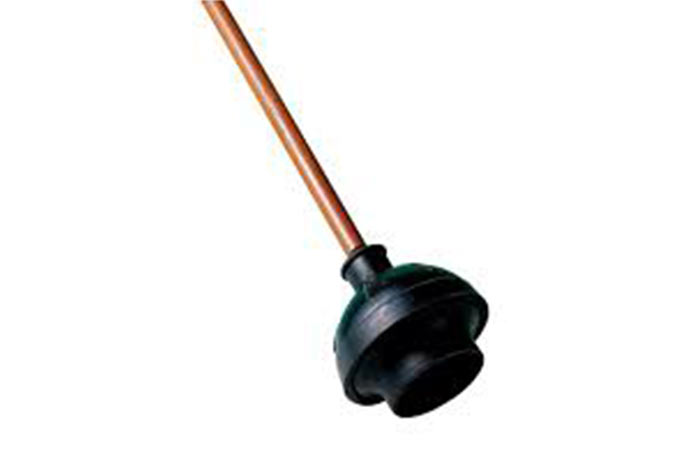
The soft rubber flap(flange)is exactly what makes it the perfect choice for the toilet since the fold-out flap fits well in the toilet drain. This will then create a vacuum and the necessary pressure needed to clear any toilet clogs.
This plunger is specifically designed for toilet drains but you can fold the flange inside the cup, to use it on a sink or tub drain to create a seal.
If you had to choose one plunger for all your home needs; this is the choice. However, it’s not recommended to have one plunger for all surfaces as this can lead to cross-contamination, and frankly, it’s simply unhygienic.
Further Reading
- How to Clean a Toilet Plunger in 4 Easy Ways + Storage Ideas
- Can Plunging a Toilet Damage the Wax Ring?
- All Types of Plungers for Toilet and Bathroom Sinks
How are Sink and Toilet Plungers the Same?
The following are some of the similarities between sink and toilet plungers
Both the toilet and sink plunger have cups that are made of rubber.
They also both have wooden handles, although toilet plunger handles are rarely made of wood, but they exist.
The purpose of both of these types of plungers is to clear clogs using pressure and suction.
Both of these devices come in two parts; the suction cup base and the handle.
Can you use a Sink Plunger to Unclog a Toilet?
Sink plungers cannot be used to unclog toilets because their flat ends do not form a tight seal in curved toilet bowl drains. Without a tight seal, there won’t be a vacuum to generate suction force. A broken seal results in splashing a lot of water.
Sink plungers are built to be used on a flat surface where the cup can lay flat over the drain and create the vacuum necessary to dislodge the clog.
Moreover, using a sink plunger to unclog a toilet is obviously not hygienic. It may lead to health hazards that may end at the hospital.
Can I use the Toilet Plunger on the Kitchen Sink?
Yes, you can a toilet plunger to unclog sinks in the bathroom as well as the kitchen. All you need to do is to fold and push it inside the cup, upwards to create a flat end. However, this is unhygienic since the toilet is a habitat for germs and disease-causing microorganisms including bacteria.
You are likely to transfer the germs that contaminate the kitchen sinks and other fittings.
What is the Best Plunger the Toilet/Sink?
An easy way to tell what plunger is the best for your toilet drain or sink is by looking at the plunger and the surface around the drain you want to unclog.
If you have flat or near flat surfaces, your plunger’s bottom should be flat to lay level against the drain allowing for a tight seal and enough suction to clear the obstruction.
If the working surface is uneven or curvy, use the flange type of plunger since it is designed to fit well into the drain hole. The following are some of the best brands of sink and toilet plungers
The Simplehuman Toilet Plunger is one of the best. We recommend it because is durable, easy to use, has adequate suction power, sturdy, and easy to clean and store.
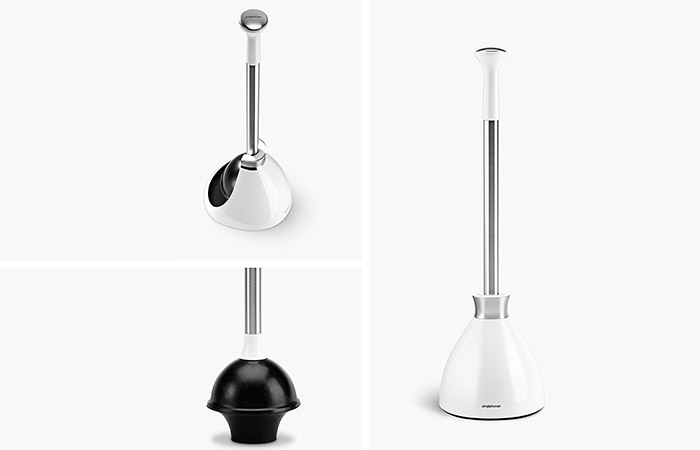
It comes with a high-quality stainless-steel rod that can withstand vigorous use.
Its flange is designed with a narrow profile to work more efficiently with modern toilets.
It has a unique magnetic collar that secures the cover to the plunger so you can carry them together — without a single drip hitting the floor.
The dome-shaped cover discreetly hides the plunger, while the large opening at the back makes it easy to detach.
Get Bats Out Toilet Plunger is a cheaper alternative to Simplehuman drain plunger. It comes with a large removable rubber cup and easy-to-clean plastic handle that features a storage hook.
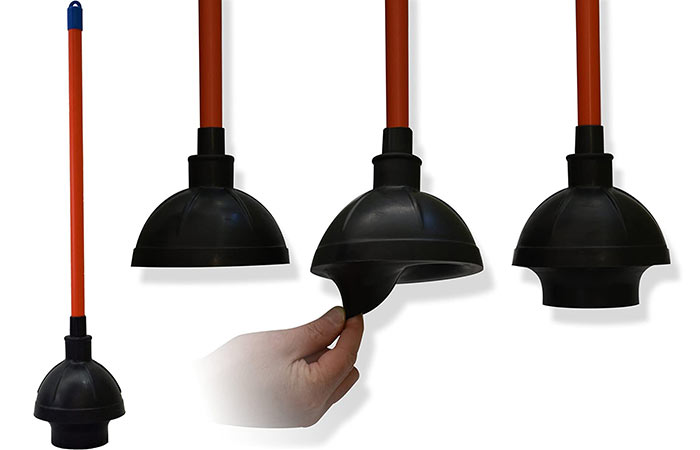
The Rocky Mountain Goods’ Standard Cup Plunger is the best-selling plunger for flat-surfaced fixtures. It is a pocket-friendly plunger that comes with a 4-inch head which allows for more pressure to unclog drain than a standard cup plunger. It features a high-grade rubber cup and a wood handle.
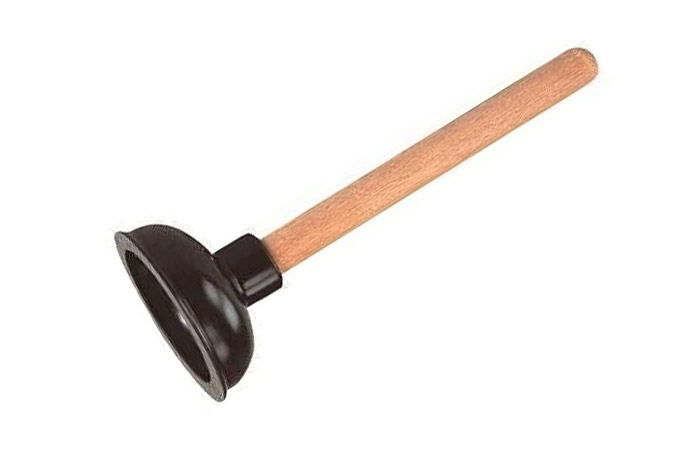
The Liquid-Plumr Mini Plunger is a good alternative to the traditional standard sink cup plunger. It is sturdy, easy to use, affordable and provides enough suction power to clear even the toughest clogs from sink, tub, and shower drains.
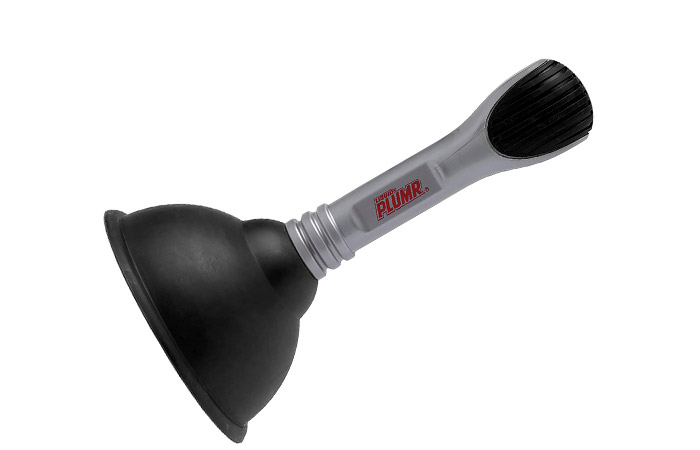
It features a 5″ flat, heavy-duty rubber bell cup for stubborn blockages. The compact size and non-slip grip handle provide additional leverage to make it easy to use
Why have a Toilet and a Sink Plunger Separately?
These are created for different applications. While toilet plungers are designed for toilet drains while sink plungers are designed for flat surfaces such as sinks.
It is also crucial to have separate plungers because of hygiene concerns. For obvious reasons, you do not want water from the toilet to be anywhere near the water you use for your hands and face. Hence just get separate plungers one for the toilet and one for the sink.
Toilet & Sink Plunging Tips
Even with the right plunger, you may not be doing the plunging the right way. Here are a few tips to aid you with that.
- Always use the right type of plunger on the right surface. The article above describes in detail which plunger is best on which surfaces
- Always hold up the plunger know in a vertical position perpendicular to the base of the household fitting.
- Always submerge the cupping part of the plunger fully into the water.
- Clear out air slowly using light strokes; especially for the flange plunger.
- If you’re unclogging a sink with a double sink design, ensure to seal the second sink as you work on the other. This way it can unclog the drain on both sides.
- Ensure you don’t break the suction seal as you plunge.
- Plunger size matters. Don’t use a mini plunger on a wide sink, you’ll only be introducing more negative air in the drain.
- Always check for cracks, tears, or breaks on the flange/ cup before you begin plunging.
- If you have adjacent sinks or tubs from where you’re trying to unclog, close them up as well to create positive pressure.
- Don’t indulge in forceful thrusts unless the clog is persistent.
- If the plunging isn’t helping, avoid the use of chemical treatments and simply seek professional assistance from plumbers.